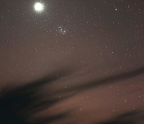NEWS NOTES

Arecibo collapse signals the end of an era
ON THE MORNING OF DECEMBER 1, a rumble echoed through the hilly terrain surrounding Arecibo, the iconic 305-metre-wide radio telescope nestled in a natural sinkhole in Puerto Rico. The 900-tonne receiver platform that had been suspended above the dish had come crashing down.
While no injuries occurred, the collapse ended hopes for a controlled dismantling of the telescope, which National Science Foundation (NSF) officials had announced less than two weeks earlier after two unexpected and devastating events that compromised the safety of the telescope.
First, an auxiliary cable, which helped suspend the receiver platform, tore out of its socket on August 10, gashing the dish below. A redundant design transferred the load of that auxiliary cable to the four original cables and the remaining support cable. Engineers were called in to assess the damage and, after determining the structure was stable, to begin repairs.
Replacement cables were on order, but before they could arrive, one of the main cables from the same tower snapped on November 6. This unexpected second break caused engineers to doubt the entire structure’s integrity.
“Any engineering approach to better understanding the strength left in the main cables involves considerable risk for human life and could in fact accelerate the uncontrolled collapse of the structure,” said Ralph Gaume, director of NSF’s Division of Astronomical Sciences.
Engineers warned that another cable break would cause “catastrophic failure”. A representative from the engineering firm Thornton Tomasetti wrote in support of dismantling the telescope: “We believe the structure will collapse in the near future if left untouched.” Drone footage in the days following the announcement showed additional breakages in the remaining cables.
Ultimately, the uncontrolled collapse happened before engineers could devise a plan for controlled decommmissioning. A preliminary assessment indicated that the top sections
You’re reading a preview, subscribe to read more.
Start your free 30 days

